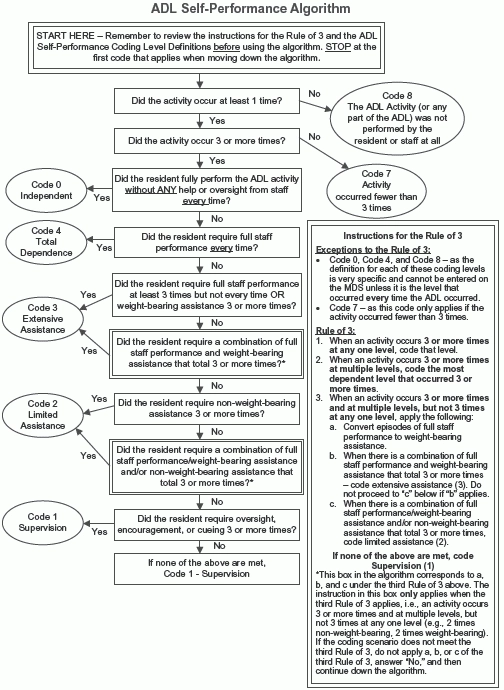MDS 3.0:
Oops: Check Out 3 Corrections On Key Parts Of Revised RAI Manual Release
Published on Mon Nov 18, 2013
Take a second look at a much-changed ADL Algorithm.
The ink is barely dry on the latest revision to the Resident Assessment Instrument (RAI) manual, and already the Centers for Medicare & Medicaid Services (CMS) is offering up handfuls of both minor and major corrections.
CMS released the revised manual in late September, with the changes effective as of Oct. 1. On Nov. 5, CMS released three corrections to the RAI Manual v1.11, Chapter 3:
1. Change table page from Section O (page 3) — the change table was incorrectly transcribed;
2. Coding examples in Section O (page O-33); and
3. The flowchart “ADL Self-Performance Algorithm” found in Section G (page G-7).
Pay Attention to Corrected O0420 Examples
The Section O coding examples on page O-33 were part of the coding instructions for Item O0420 — Distinct Calendar Days of Therapy. O0420 was a new item that CMS added to the most recent RAI manual revision.
According to the manual, the coding instructions for O0420 are: “Enter the number of calendar days that the resident received Speech-Language Pathology and Audiology Services, Occupational Therapy, or Physical Therapy for at least 15 minutes in the past 7 days. If a resident receives more than one therapy discipline on a given calendar day, this may only count for one calendar day for purposes of coding Item O0420.”
Take note: The revised, corrected examples are as follows:
-
“Example 1: Mrs. T. received 60 minutes of physical therapy on Monday, Wednesday and Friday within the 7-day look-back period. Mrs. T also received 45 minutes of occupational therapy on Monday, Tuesday and Friday during the 7-day look-back period. Given the therapy services received by Mrs. T during the 7-day look-back period, item O0420 would be coded as 4 because therapy services were provided for at least 15 minutes on 4 distinct calendar days during the 7-day look-back period (i.e., Monday, Tuesday, Wednesday, and Friday).
-
“Example 2: Mr. F. received 120 minutes of physical therapy on Monday, Wednesday and Friday within the 7-day look-back period. Mr. F also received 90 minutes of occupational therapy on Monday, Wednesday and Friday during the 7-day look-back period. Finally, Mr. F received 60 minutes of speech-language pathology services on Monday and Friday during the 7-day look-back period. Given the therapy services received by Mr. F during the 7-day look-back period, item O0420 would be coded as 3 because therapy services were provided for at least 15 minutes on 3 distinct calendar days during the 7-day look-back period (i.e., Monday, Wednesday, and Friday).”
How the ADL Algorithm Now Looks Different
CMS made a variety of changes to the ADL Self-Performance Algorithm (see page 123 for the corrected Algorithm), which essentially provides a flowchart for correctly coding Item G0110 — Activities of Daily Living (ADL) Assistance based on the Rule of 3. Here’s a rundown of the changes:
-
Before, the Algorithm stated, “Code 7 Activity Occurred only 1 or 2 times” in the circle that indicated a “No” answer to “Did the activity occur 3 or more times?” But CMS revised this to read: “Code 7 Activity occurred fewer than 3 times.”
-
In the circle indicating a “Yes” answer to “Did the resident require full staff performance every time?,” CMS changed the text from “Code 4 Dependence” to “Code 4 Total Dependence.”
-
CMS changed the language slightly in “Did the resident require a combination of full staff performance and weight-bearing assistance 3 or more times?” to read, “Did the resident require a combination of full staff performance and weight-bearing assistance that total 3 or more times?”

Also: Corrections to the “Instructions for the Rule of 3” box in the algorithm include:
-
In the first bullet under “Exceptions to the Rule of 3,” CMS changes the word “finite” to “very specific.” The second bullet now reads, “Code 7 — as this code only applies if the activity occurred fewer than 3 times.”
-
CMS revises number 2 under the “Rule of 3” section to read: “When an activity occurs 3 or more times at multiple levels, code the most dependent level that occurred 3 or more times.”
-
And number 3b now reads: “When there is a combination of full staff performance and weight-bearing assistance that total 3 or more times — code extensive assistance (3). Do not proceed to ‘c’ below if ‘b’ applies.”
-
Number 3c now reads: “When there is a combination of full staff performance/weight-bearing assistance and/or non-weight-bearing assistance that total 3 or more times, code limited assistance (2).”
Link: To view the corrections, go to www.cms.gov/Medicare/Quality-Initiatives-Patient-Assessment-Instruments/NursingHomeQualityInits/MDS30RAIManual.html and scroll down to the Downloads section at the bottom of the page. Note that CMS has marked corrected pages in the manual and the change tables with an (R).

